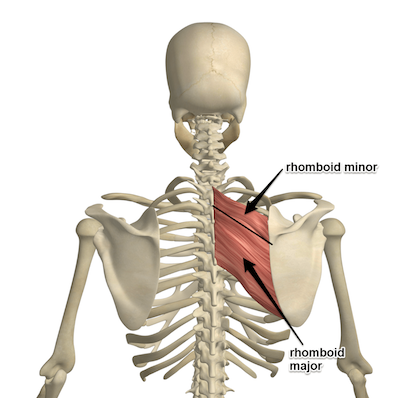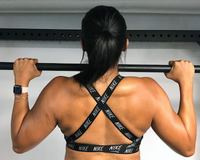
The Pendlay row is one of the most effective back exercises. Named after USA weightlifting coach Glenn Pendlay, this barbell row variation will help you improve your posture and build a stronger back.
The Pendlay row is an advanced back exercise that can take your upper body training to the next level.
Muscles Worked By The Pendlay Row
Primary Muscle Groups:
The Pendlay row primarily works muscles in your mid and upper back such as your lats and rhomboids.
Originating in the lower/mid back, the latissimus dorsi is the largest muscle of the back. Your lats play a significant role in most “pulling” exercises such as the lat pulldown, pull ups, and other rowing exercises.

Your rhomboids are located in your upper back. When you contract the rhomboids at the top of each rep of the Pendlay row, they are responsible for bringing your shoulder blades together.

Secondary Muscle Groups
The Pendlay row is a true compound exercise, as it secondarily works muscles throughout your body such as the biceps, forearms, abs, glutes, legs, traps, and deltoids. During the exercise motion, your biceps and forearms contract to bring the weight up and a wide variety of other muscles also help to stabilize the upper body.
Your legs and glutes also activate to stabilize the lower body in the bent over position. While the Pendlay row is a back exercise, it incorporates muscles throughout the body.
Pendlay Row Benefits
1. Bigger & Stronger Back
The Pendlay row places an intense stress on your back muscles. As a result, your individual muscle cells respond by increasing in size; this process is called hypertrophy. This will help you build a bigger, stronger back. Not only is a sturdy back aesthetically pleasing, it is also essential for improving your performance in athletics, other compound lifts, and simple day-to-day activities.
2. Full Body Activation
In other back exercises such as the dumbbell row or lat pulldown, you have a bench or cable machine to help stabilize the movement. With the Pendlay row, you begin each rep in a stationary position.
Therefore, you must rely on yourself for stability. For that reason, if you are a novice weightlifter, make sure you build up strength in your lower back and core before lifting heavy weights with the Pendlay row. This is a demanding exercise that will test your total-body stability.
3. Improved Posture
Hours of sitting in chairs at work or while driving can cause you to underutilize your lats and other back muscles. As a result, this can lead to slouching, pain, and tension in your shoulders and back. The Pendlay row can help to activate these under utilized muscles and reduce back pain or discomfort. With regular exercise, your back muscle will grow to support your upper body and help to provide a stable frame for proper posture.
How To Do The Pendlay Row
Equipment:
For this exercise, you will need a barbell and some weights.
Setup:
a) Set up a barbell on the ground with light to medium weight.
b) Assume a standing position with your feet shoulder width apart. Step forward so that the barbell is over the middle portion of your feet.
c) Hinge at the waist and bend your knees so that your back is roughly parallel to the floor.
d) Grab the bar with an overhand grip with your hands wider than shoulder width apart.
Action:
a) Keeping your elbows slightly tucked, brace your core and contract your lats to drive your elbows up and back, bringing the barbell towards the bottom of your chest.
b) Squeeze your lats at the top, pause for a moment, and slowly bring the barbell back to the floor in the starting position.
c) Maintain tightness in your core and back and repeat!

Recommendation:
You should aim to complete 3-4 sets of 8-12 reps of the Pendlay row. As you get more comfortable with the form, feel free to change up your set and rep ranges to challenge yourself.
Pendlay Row Mistakes
1. Standing Too Upright
I often see lifters slowly stand more upright as they complete multiple reps of the Pendlay row. This most often occurs because they are using momentum to lift too much weight.
The Pendlay row is a fantastic back exercise because it relies upon strict form. Instead of using momentum to lift upwards, choose a manageable weight and keep your back flat and nearly parallel to the floor. This will reduce your risk of injury and maximize your gains!
2. Lifting With Your Arms
Many lifters tend to bow their wrists and use their arms to pull the weight up. This most often occurs when people try to lift too much weight. As a result, they will use their arms to gain momentum and “bounce” at the top of each rep.
Not only is this unsafe for your wrists and back, but it doesn’t actually accomplish the goal of safely stressing your back muscles. Instead, choose a lighter weight and focus on proper form.
3. Rounding The Back
Another common Pendlay row mistake is rounding the back. This mistake usually happens due to a faulty set up position. However, it can also happen if you relax your back position in between reps.
Rounding your back puts your body in a compromised position, which can lead to injury. Throughout the Pendlay row, focus on keeping your chest up and your back engaged in a neutral, flat position.
This will maximize the safety and the effectiveness of the Pendlay row.
Pendlay Row Variations
1. 1-Arm Pendlay Row
You can also perform the Pendlay row unilaterally.
Set up a dumbbell or kettlebell (as pictured below) on the ground. Assume a standing position with your feet shoulder width apart. Step forward so that the weight is placed just in front of your right foot. Hinge at the waist and bend your knees so that your back is roughly parallel to the floor.
Grab the weight, brace your core and contract your right lat to drive your elbow up and back, bringing the weight towards the bottom of your chest.
Squeeze your lat at the top, pause for a moment, and slowly bring the weight back to the floor in the starting position. Maintain tightness in your core and back and repeat with the left arm!

2. Pendlay Row Grip Variations
The traditional Pendlay row calls for a wide overhand grip. However, simply changing your grip can make a huge difference for targeting different muscles. For example, try an underhand grip for more bicep activation or bring your hands closer together to better target your mid-back.
Try different grip variations to see what works best for you!
Pendlay Row Alternatives
If you enjoyed the Pendlay row, check out these back exercises to improve your upper body training:
1. Overhand Barbell Row
Set up a barbell on the ground with light to medium weight. Assume a standing position with your feet shoulder width apart. Step forward so that the barbell is over the middle portion of your feet. Grab the bar with an overhand grip with your hands just outside your knees.
Brace your abs and back and lift the barbell off the ground until you are in a standing position with your back straight.
Keeping your abs and back tight, hinge your hips backwards until your back is nearly parallel to the floor. Extend your arms straight down and keep your gaze focused a few feet in front of you. Keeping your elbows tucked, drive your elbows up and back to bring the barbell up towards your belly button.
Squeeze your lats at the top, pause for a moment, and slowly return to the starting position. Maintain tightness in your core and back and repeat!

2. Straight Arm Pullover
Lie on your back with your knees bent and your feet planted on the ground. Grasp a pair of dumbbells with an overhand grip and extend your arms straight up above your chest.
Slowly bring your arms back until the dumbbells touch the ground. Then, squeeze your lats to bring them back to the starting position. Repeat!

3. Reverse Snow Angel
Lie on your stomach with your hands above your head and your palms facing down. Pick your shoulders up to transition your arms down to the side of your body with your palms now facing up.
On the transfer, try to lift your arms as high as possible to maximize back engagement. Then, lift your shoulders up again and bring your arms back to the starting position following the same rotation of hand positioning. You should be squeezing your lats hard the whole time throughout this exercise. Repeat!

Looking For A Full Back Workout?
Check out this intense 5 minute barbell back workout!
Join the Invasion!
This Anabolic Aliens membership will grant you access to workout classes, rehab programs, diet plans, and more exclusive content to help you achieve sustainable success!










